2022
|
 | Potterf, Mária; Svitok, Marek; Mezei, Pavel; Jarčuška, Benjamín; Jakuš, Rastislav; Blaženec, Miroslav; Hlásny, Tomáš Contrasting Norway spruce disturbance dynamics in managed forests and strict forest reserves in Slovakia Journal Article Forestry, 96 (3), pp. 387–398, 2022, ISSN: 1464-3626. Links | BibTeX @article{Potterf_2022,
title = {Contrasting Norway spruce disturbance dynamics in managed forests and strict forest reserves in Slovakia},
author = {Mária Potterf and Marek Svitok and Pavel Mezei and Benjamín Jarčuška and Rastislav Jakuš and Miroslav Blaženec and Tomáš Hlásny},
editor = {Dominik Thom},
url = {http://dx.doi.org/10.1093/forestry/cpac045},
doi = {10.1093/forestry/cpac045},
issn = {1464-3626},
year = {2022},
date = {2022-11-01},
journal = {Forestry},
volume = {96},
number = {3},
pages = {387–398},
publisher = {Oxford University Press (OUP)},
keywords = {},
pubstate = {published},
tppubtype = {article}
}
|
 | Mezei, Pavel; Fleischer, Peter; Rozkošný, Jozef; Kurjak, Daniel; Dzurenko, Marek; Rell, Slavomír; Lalík, Michal; Galko, Juraj Weather conditions and host characteristics drive infestations of sessile oak (Quercus petraea) trap trees by oak bark beetles (Scolytus intricatus) Journal Article Forest Ecology and Management, 503 , pp. 119775, 2022, ISSN: 0378-1127. Links | BibTeX @article{Mezei_2022,
title = {Weather conditions and host characteristics drive infestations of sessile oak (Quercus petraea) trap trees by oak bark beetles (Scolytus intricatus)},
author = {Pavel Mezei and Peter Fleischer and Jozef Rozkošný and Daniel Kurjak and Marek Dzurenko and Slavomír Rell and Michal Lalík and Juraj Galko},
url = {http://dx.doi.org/10.1016/j.foreco.2021.119775},
doi = {10.1016/j.foreco.2021.119775},
issn = {0378-1127},
year = {2022},
date = {2022-01-01},
journal = {Forest Ecology and Management},
volume = {503},
pages = {119775},
publisher = {Elsevier BV},
keywords = {},
pubstate = {published},
tppubtype = {article}
}
|
2021
|
 | Ježík, Marek; Blaženec, Miroslav; Mezei, Pavel; Sedmáková, Denisa; Sedmák, Róbert; Fleischer, Peter; Fleischer, Peter; Bošeľa, Michal; Kurjak, Daniel; Střelcová, Katarína; Ditmarová, Ľubica Influence of weather and day length on intra-seasonal growth of Norway spruce (Picea abies) and European beech (Fagus sylvatica) in a natural montane forest Journal Article Canadian Journal of Forest Research, 51 (12), pp. 1799–1810, 2021, ISSN: 1208-6037. Links | BibTeX @article{Je_k_2021,
title = {Influence of weather and day length on intra-seasonal growth of Norway spruce (Picea abies) and European beech (Fagus sylvatica) in a natural montane forest},
author = {Marek Ježík and Miroslav Blaženec and Pavel Mezei and Denisa Sedmáková and Róbert Sedmák and Peter Fleischer and Peter Fleischer and Michal Bošeľa and Daniel Kurjak and Katarína Střelcová and Ľubica Ditmarová},
url = {http://dx.doi.org/10.1139/cjfr-2020-0067},
doi = {10.1139/cjfr-2020-0067},
issn = {1208-6037},
year = {2021},
date = {2021-12-01},
journal = {Canadian Journal of Forest Research},
volume = {51},
number = {12},
pages = {1799–1810},
publisher = {Canadian Science Publishing},
keywords = {},
pubstate = {published},
tppubtype = {article}
}
|
 | Jančo, Martin; Mezei, Pavel; Kvas, Andrej; Danko, Michal; Sleziak, Patrik; Minďáš, Jozef; Škvarenina, Jaroslav Effect of mature spruce forest on canopy interception in subalpine conditions during three growing seasons Journal Article Journal of Hydrology and Hydromechanics, 69 (4), pp. 436–446, 2021, ISSN: 1338-4333. Links | BibTeX @article{Jan_o_2021,
title = {Effect of mature spruce forest on canopy interception in subalpine conditions during three growing seasons},
author = {Martin Jančo and Pavel Mezei and Andrej Kvas and Michal Danko and Patrik Sleziak and Jozef Minďáš and Jaroslav Škvarenina},
url = {http://dx.doi.org/10.2478/johh-2021-0025},
doi = {10.2478/johh-2021-0025},
issn = {1338-4333},
year = {2021},
date = {2021-11-01},
journal = {Journal of Hydrology and Hydromechanics},
volume = {69},
number = {4},
pages = {436–446},
publisher = {Walter de Gruyter GmbH},
keywords = {},
pubstate = {published},
tppubtype = {article}
}
|
 | Angelstam, Per; Albulescu, Andra-Cosmina; Andrianambinina, Ollier Duranton F; Aszalós, Réka; Borovichev, Eugene; Cardona, Walter Cano; Dobrynin, Denis; Fedoriak, Mariia; Firm, Dejan; Hunter, Malcolm L; de Jong, Wil; Lindenmayer, David; Manton, Michael; Monge, Juan J; Mezei, Pavel; Michailova, Galina; Brenes, Carlos Muñoz L; Pastur, Guillermo Martínez; Petrova, Olga V; Petrov, Victor; Pokorny, Benny; Rafanoharana, Serge C; Rosas, Yamina Micaela; Seymour, Bob Robert; Waeber, Patrick O; Wilmé, Lucienne; Yamelynets, Taras; Zlatanov, Tzvetan Frontiers of protected areas versus forest exploitation: Assessing habitat network functionality in 16 case study regions globally Journal Article Ambio, 50 (12), pp. 2286–2310, 2021, ISSN: 1654-7209. Links | BibTeX @article{Angelstam_2021,
title = {Frontiers of protected areas versus forest exploitation: Assessing habitat network functionality in 16 case study regions globally},
author = {Per Angelstam and Andra-Cosmina Albulescu and Ollier Duranton F Andrianambinina and Réka Aszalós and Eugene Borovichev and Walter Cano Cardona and Denis Dobrynin and Mariia Fedoriak and Dejan Firm and Malcolm L Hunter and Wil de Jong and David Lindenmayer and Michael Manton and Juan J Monge and Pavel Mezei and Galina Michailova and Carlos Muñoz L Brenes and Guillermo Martínez Pastur and Olga V Petrova and Victor Petrov and Benny Pokorny and Serge C Rafanoharana and Yamina Micaela Rosas and Bob Robert Seymour and Patrick O Waeber and Lucienne Wilmé and Taras Yamelynets and Tzvetan Zlatanov},
url = {http://dx.doi.org/10.1007/s13280-021-01628-5},
doi = {10.1007/s13280-021-01628-5},
issn = {1654-7209},
year = {2021},
date = {2021-01-01},
journal = {Ambio},
volume = {50},
number = {12},
pages = {2286–2310},
publisher = {Springer Science and Business Media LLC},
keywords = {},
pubstate = {published},
tppubtype = {article}
}
|
2020
|
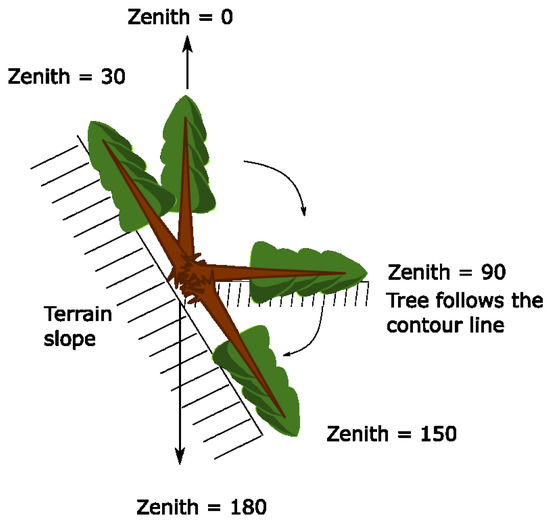 | Hroššo, Branislav; Mezei, Pavel; Potterf, Mária; Majdák, Andrej; Blaženec, Miroslav; Korolyova, Nataliya; Jakuš, Rastislav Drivers of Spruce Bark Beetle (Ips typographus) Infestations on Downed Trees after Severe Windthrow Journal Article Forests, 11 , 2020, ISSN: 1999-4907. Abstract | Links | BibTeX @article{Hroššo2020,
title = {Drivers of Spruce Bark Beetle (\textit{Ips typographus}) Infestations on Downed Trees after Severe Windthrow},
author = {Branislav Hroššo and Pavel Mezei and Mária Potterf and Andrej Majdák and Miroslav Blaženec and Nataliya Korolyova and Rastislav Jakuš},
doi = {10.3390/f11121290},
issn = {1999-4907},
year = {2020},
date = {2020-11-30},
journal = {Forests},
volume = {11},
abstract = {Research Highlights: Bark beetles are important agents of disturbance regimes in temperate forests, and specifically in a connected wind-bark beetle disturbance system. Large-scale windthrows trigger population growth of the European spruce bark beetle (Ips typographus L.) from endemic to epidemic levels, thereby allowing the killing of Norway spruce trees over several consecutive years. Background and Objectives: There is a lack of evidence to differentiate how outbreaks are promoted by the effects of environmental variables versus beetle preferences of trees from endemic to outbreak. However, little is known about how individual downed-tree characteristics and local conditions such as tree orientation and solar radiation affect beetle colonization of downed trees. Materials and Methods: To answer this question, we investigated the infestation rates and determined tree death categories (uprooted, broken, and stump) in wind-damaged areas in Western Tatra Mts. in Carpathians (Slovakia) from 2014–2016, following a windthrow in May 2014. In total, we investigated 225 trees over eight transects. For every tree, we measured its morphological (tree height, crown characteristics), environmental (solar radiation, terrain conditions, trunk zenith), temporal (time since wind damage), and beetle infestation (presence, location of attack, bark desiccation) parameters. We applied Generalized Additive Mixed Models (GAMM) to unravel the main drivers of I. typographus infestations. Results: Over the first year, beetles preferred to attack broken trees and sun-exposed trunk sides over uprooted trees; the infestation on shaded sides started in the second year along with the infestation of uprooted trees with lower desiccation rates. We found that time since wind damage, stem length, and incident solar radiation increased the probability of beetle infestation, although both solar radiation and trunk zenith exhibited nonlinear variability. Our novel variable trunk zenith appeared to be an important predictor of bark beetle infestation probability. We conclude that trunk zenith as a simple measure defining the position of downed trees over the terrain can anticipate beetle infestation. Conclusions: Our findings contribute to understanding of the bark beetle’s preferences to colonize windthrown trees in the initial years after the primary wind damage. Further, our findings can help to identify trees that are most susceptible to beetle infestation and to prioritize management actions to control beetle population while maintaining biodiversity.},
keywords = {},
pubstate = {published},
tppubtype = {article}
}
Research Highlights: Bark beetles are important agents of disturbance regimes in temperate forests, and specifically in a connected wind-bark beetle disturbance system. Large-scale windthrows trigger population growth of the European spruce bark beetle (Ips typographus L.) from endemic to epidemic levels, thereby allowing the killing of Norway spruce trees over several consecutive years. Background and Objectives: There is a lack of evidence to differentiate how outbreaks are promoted by the effects of environmental variables versus beetle preferences of trees from endemic to outbreak. However, little is known about how individual downed-tree characteristics and local conditions such as tree orientation and solar radiation affect beetle colonization of downed trees. Materials and Methods: To answer this question, we investigated the infestation rates and determined tree death categories (uprooted, broken, and stump) in wind-damaged areas in Western Tatra Mts. in Carpathians (Slovakia) from 2014–2016, following a windthrow in May 2014. In total, we investigated 225 trees over eight transects. For every tree, we measured its morphological (tree height, crown characteristics), environmental (solar radiation, terrain conditions, trunk zenith), temporal (time since wind damage), and beetle infestation (presence, location of attack, bark desiccation) parameters. We applied Generalized Additive Mixed Models (GAMM) to unravel the main drivers of I. typographus infestations. Results: Over the first year, beetles preferred to attack broken trees and sun-exposed trunk sides over uprooted trees; the infestation on shaded sides started in the second year along with the infestation of uprooted trees with lower desiccation rates. We found that time since wind damage, stem length, and incident solar radiation increased the probability of beetle infestation, although both solar radiation and trunk zenith exhibited nonlinear variability. Our novel variable trunk zenith appeared to be an important predictor of bark beetle infestation probability. We conclude that trunk zenith as a simple measure defining the position of downed trees over the terrain can anticipate beetle infestation. Conclusions: Our findings contribute to understanding of the bark beetle’s preferences to colonize windthrown trees in the initial years after the primary wind damage. Further, our findings can help to identify trees that are most susceptible to beetle infestation and to prioritize management actions to control beetle population while maintaining biodiversity. |
2019
|
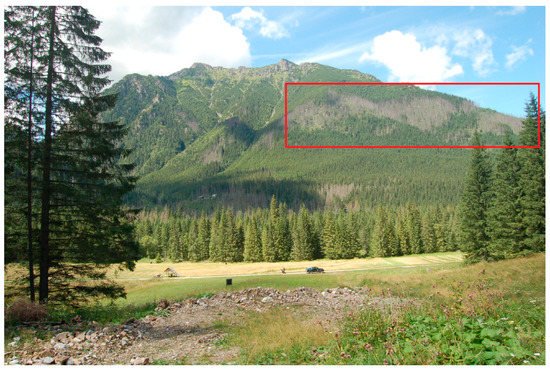 | Mezei, Pavel; Potterf, Mária; Škvarenina, Jaroslav; Rasmussen, Jakob Gulddahl; Jakuš, Rastislav Potential Solar Radiation as a Driver for Bark Beetle Infestation on a Landscape Scale Journal Article Forests, 10 (7), 2019, ISSN: 1999-4907. Abstract | Links | BibTeX @article{Mezei2019,
title = {Potential Solar Radiation as a Driver for Bark Beetle Infestation on a Landscape Scale},
author = {Pavel Mezei and Mária Potterf and Jaroslav Škvarenina and Jakob Gulddahl Rasmussen and Rastislav Jakuš},
doi = {10.3390/f10070604},
issn = {1999-4907},
year = {2019},
date = {2019-07-19},
journal = {Forests},
volume = {10},
number = {7},
abstract = {In recent decades, Norway spruce (Picea abies L. Karst.) forests of the High Tatra Mountains have suffered unprecedented tree mortality caused by European spruce bark beetle (Ips typographus L.). Analysis of the spatiotemporal pattern of bark beetle outbreaks across the landscape in consecutive years can provide new insights into the population dynamics of tree-killing insects. A bark beetle outbreak occurred in the High Tatra Mountains after a storm damaged more than 10,000 ha of forests in 2004. We combined yearly Landsat-derived bark beetle infestation spots from 2006 to 2014 and meteorological data to identify the susceptibility of forest stands to beetle infestation. We found that digital elevation model (DEM)-derived potential radiation loads predicted beetle infestation, especially in the peak phase of beetle epidemic. Moreover, spots attacked at the beginning of our study period had higher values of received solar radiation than spots at the end of the study period, indicating that bark beetles prefer sites with higher insolation during outbreak. We conclude that solar radiation, easily determined from the DEM, better identified beetle infestations than commonly used meteorological variables. We recommend including potential solar radiation in beetle infestation prediction models. },
keywords = {},
pubstate = {published},
tppubtype = {article}
}
In recent decades, Norway spruce (Picea abies L. Karst.) forests of the High Tatra Mountains have suffered unprecedented tree mortality caused by European spruce bark beetle (Ips typographus L.). Analysis of the spatiotemporal pattern of bark beetle outbreaks across the landscape in consecutive years can provide new insights into the population dynamics of tree-killing insects. A bark beetle outbreak occurred in the High Tatra Mountains after a storm damaged more than 10,000 ha of forests in 2004. We combined yearly Landsat-derived bark beetle infestation spots from 2006 to 2014 and meteorological data to identify the susceptibility of forest stands to beetle infestation. We found that digital elevation model (DEM)-derived potential radiation loads predicted beetle infestation, especially in the peak phase of beetle epidemic. Moreover, spots attacked at the beginning of our study period had higher values of received solar radiation than spots at the end of the study period, indicating that bark beetles prefer sites with higher insolation during outbreak. We conclude that solar radiation, easily determined from the DEM, better identified beetle infestations than commonly used meteorological variables. We recommend including potential solar radiation in beetle infestation prediction models. |
 | Potterf, Mária; Nikolov, Christo; Kočická, Erika; Ferenčík, Ján; Mezei, Pavel; Jakuš, Rastislav Landscape-level spread of beetle infestations from windthrown- and beetle-killed trees in the non-intervention zone of the Tatra National Park, Slovakia (Central Europe) Journal Article Forest Ecology and Management, 432 , pp. 489-500, 2019, ISSN: 0378-1127. Links | BibTeX @article{Potterf2019,
title = {Landscape-level spread of beetle infestations from windthrown- and beetle-killed trees in the non-intervention zone of the Tatra National Park, Slovakia (Central Europe)},
author = {Mária Potterf and Christo Nikolov and Erika Kočická and Ján Ferenčík and Pavel Mezei and Rastislav Jakuš},
doi = {10.1016/j.foreco.2018.09.050},
issn = {0378-1127},
year = {2019},
date = {2019-01-15},
journal = {Forest Ecology and Management},
volume = {432},
pages = {489-500},
keywords = {},
pubstate = {published},
tppubtype = {article}
}
|
2017
|
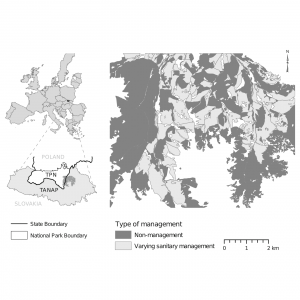 | Mezei, Pavel; Blaženec, Miroslav; Grodzki, Wojciech; Škvarenina, Jaroslav; Jakuš, Rastislav Influence of different forest protection strategies on spruce tree mortality during a bark beetle outbreak Journal Article Annals of Forest Science, 74 , 2017, ISSN: 1297-966X. Links | BibTeX @article{Mezei2017b,
title = {Influence of different forest protection strategies on spruce tree mortality during a bark beetle outbreak},
author = {Pavel Mezei and Miroslav Blaženec and Wojciech Grodzki and Jaroslav Škvarenina and Rastislav Jakuš},
url = {http://rdcu.be/wnGe},
doi = {doi.org/10.1007/s13595-017-0663-9},
issn = {1297-966X},
year = {2017},
date = {2017-09-27},
journal = {Annals of Forest Science},
volume = {74},
keywords = {},
pubstate = {published},
tppubtype = {article}
}
|
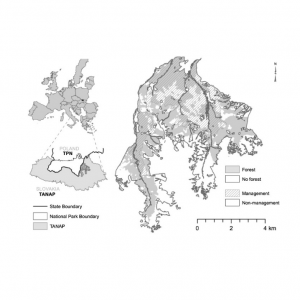 | Mezei, P; Jakuš, R; Pennerstorfer, J; Havašová, M; Škvarenina, J; Ferenčík, J; Slivinský, J; Bičárová, S; Bilčík, D; Blaženec, M; Netherer, S Storms, temperature maxima and the Eurasian spruce bark beetle Ips typographus — an infernal trio in Norway spruce forests of the Central European High Tatra Mountains Journal Article Agricultural and Forest Meteorology, 242 , pp. 85-95, 2017. Abstract | Links | BibTeX @article{Mezei2017,
title = {Storms, temperature maxima and the Eurasian spruce bark beetle \textit{Ips typographus} — an infernal trio in Norway spruce forests of the Central European High Tatra Mountains},
author = {P. Mezei and R. Jakuš and J. Pennerstorfer and M. Havašová and J. Škvarenina and J. Ferenčík and J. Slivinský and S. Bičárová and D. Bilčík and M. Blaženec and S. Netherer},
url = {http://ife.sk/wp-content/uploads/2016/10/Figure_4_20170406_2-pdf-300x192.jpghttp://www.sciencedirect.com/science/article/pii/S0168192317301326},
doi = {10.1016/j.agrformet.2017.04.004},
year = {2017},
date = {2017-04-10},
journal = { Agricultural and Forest Meteorology},
volume = {242},
pages = {85-95},
abstract = {Norway spruce forests (Picea abies Karst.) of the Carpathian High Tatra Mountains have been subject to unprecedented tree mortality caused by attacks of the Eurasian spruce bark beetle (Ips typographus L.) in recent decades. The outbreaks were preceded and accompanied by wind throw events and periods of increased seasonal temperature. We obtained climatic data and data on tree mortality due to storm throw and bark beetles by using a combination of direct dead tree inventory and remote sensing techniques, and examined annual tree loss change over a 26-year period in a forest district of the Slovak High Tatra National Park. In particular, we found that the combination of the previous year's maximum daily temperature sum, tree mortality caused by wind, and bark beetle-caused tree mortality best explained the annual tree loss change in nonlinear regression models. The number of trees infested by bark beetles clearly increased with maximum air temperature sums ranging from 2850 to 3150 ° days, but declined below or above this thermal optimum. Annual tree mortality clearly increased subsequent to years associated with seasonal temperature sums allowing for the development of sister broods. Given consistently favourable future climatic conditions for development of I. typographus populations in the study area, a possible shift from the now predominantly uni-voltine to multi-voltine bark beetle populations might increase attack pressure also at high elevation sites.},
keywords = {},
pubstate = {published},
tppubtype = {article}
}
Norway spruce forests (Picea abies Karst.) of the Carpathian High Tatra Mountains have been subject to unprecedented tree mortality caused by attacks of the Eurasian spruce bark beetle (Ips typographus L.) in recent decades. The outbreaks were preceded and accompanied by wind throw events and periods of increased seasonal temperature. We obtained climatic data and data on tree mortality due to storm throw and bark beetles by using a combination of direct dead tree inventory and remote sensing techniques, and examined annual tree loss change over a 26-year period in a forest district of the Slovak High Tatra National Park. In particular, we found that the combination of the previous year's maximum daily temperature sum, tree mortality caused by wind, and bark beetle-caused tree mortality best explained the annual tree loss change in nonlinear regression models. The number of trees infested by bark beetles clearly increased with maximum air temperature sums ranging from 2850 to 3150 ° days, but declined below or above this thermal optimum. Annual tree mortality clearly increased subsequent to years associated with seasonal temperature sums allowing for the development of sister broods. Given consistently favourable future climatic conditions for development of I. typographus populations in the study area, a possible shift from the now predominantly uni-voltine to multi-voltine bark beetle populations might increase attack pressure also at high elevation sites. |
2015
|
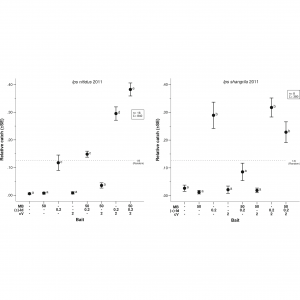 | Schlyter, F; Jakuš, R; Han, F Z; Kalinová, B; Mezei, P; Sun, J H; Ma, J H; Ujhelyiová, L; Zhang, Q H Reproductive isolation of Ips nitidus and I. shangrila in mountain forests of Western China: responses to chiral and achiral candidate pheromone components Journal Article Journal of Chemical Ecology, 41 (7), pp. 678-688, 2015. Links | BibTeX @article{F.2015,
title = {Reproductive isolation of \textit{Ips nitidus} and \textit{I. shangrila} in mountain forests of Western China: responses to chiral and achiral candidate pheromone components},
author = {F. Schlyter and R. Jakuš and F.Z. Han and B. Kalinová and P. Mezei and J.H. Sun and J.H. Ma and L. Ujhelyiová and Q.H. Zhang},
url = {https://www.ncbi.nlm.nih.gov/pubmed/26112107},
year = {2015},
date = {2015-07-01},
journal = {Journal of Chemical Ecology},
volume = {41},
number = {7},
pages = {678-688},
keywords = {},
pubstate = {published},
tppubtype = {article}
}
|
![Hodnotenie zdravotného stavu smreka vo vzťahu smreka k náletu podkôrneho hmyzu a k odumieraniu lesa [Evaluation of Norway spruce helath status in relationships with bark beetle outbreak and forest dying]](https://ife.sk/wp-content/uploads/2016/10/IFE_blazenec_02.png) | Jakuš, R; Cudlín, P; Slivinský, J; Mezei, P; Majdák, A; Blaženec, M Hodnotenie zdravotného stavu smreka vo vzťahu smreka k náletu podkôrneho hmyzu a k odumieraniu lesa [Evaluation of Norway spruce helath status in relationships with bark beetle outbreak and forest dying] Book Ústav ekológie lesa, Slovenská akadémia vied, Zvolen, 2015, ISBN: 978-80-89408-22-1. Links | BibTeX @book{Jakuš2015,
title = {Hodnotenie zdravotného stavu smreka vo vzťahu smreka k náletu podkôrneho hmyzu a k odumieraniu lesa [Evaluation of Norway spruce helath status in relationships with bark beetle outbreak and forest dying]},
author = {R. Jakuš and P. Cudlín and J. Slivinský and P. Mezei and A. Majdák and M. Blaženec},
url = {https://www.researchgate.net/publication/280014410_Hodnotenie_zdravotneho_stavu_smreka_vo_vztahu_k_naletu_podkorneho_hmyzu_a_k_odumieraniu_lesa},
isbn = {978-80-89408-22-1},
year = {2015},
date = {2015-01-01},
booktitle = {Prognosticko-informačné systémy pre zvýšenie efektívnosti manažmentu lesa},
publisher = {Ústav ekológie lesa, Slovenská akadémia vied},
address = {Zvolen},
keywords = {},
pubstate = {published},
tppubtype = {book}
}
|
![Princípy ochrany dospelých smrekových porastov pred podkôrnym hmyzom [Conservation principles of mature Norway spruce trees attacked by bark beetles]](https://ife.sk/wp-content/uploads/2016/10/IFE_blazenec_03.png) | Jakuš, R; Blaženec, M; Gurtsev, A I; Holuša, J; Hroššo, B; Křenová, Z; Longauerová, V; Lukášová, K; Majdák, A; Mezei, P; Slivinský, J Princípy ochrany dospelých smrekových porastov pred podkôrnym hmyzom [Conservation principles of mature Norway spruce trees attacked by bark beetles] Book Ústav ekológie lesa, Slovenská akadémia vied, Zvolen, 2015, ISBN: 978-80-89408-21-4. Links | BibTeX @book{Jakuš2015b,
title = {Princípy ochrany dospelých smrekových porastov pred podkôrnym hmyzom [Conservation principles of mature Norway spruce trees attacked by bark beetles]},
author = {R. Jakuš and M. Blaženec and A.I. Gurtsev and J. Holuša and B. Hroššo and Z. Křenová and V. Longauerová and K. Lukášová and A. Majdák and P. Mezei and J. Slivinský},
editor = {R. Jakuš and M. Blaženec},
url = {https://www.researchgate.net/publication/280883448_Principy_ochrany_dospelych_smrekovych_porastov_pred_podkornym_hmyzom},
isbn = {978-80-89408-21-4},
year = {2015},
date = {2015-01-01},
booktitle = {Prognosticko-informačné systémy pre zvýšenie efektívnosti manažmentu lesa},
publisher = {Ústav ekológie lesa, Slovenská akadémia vied},
address = {Zvolen},
keywords = {},
pubstate = {published},
tppubtype = {book}
}
|
2014
|
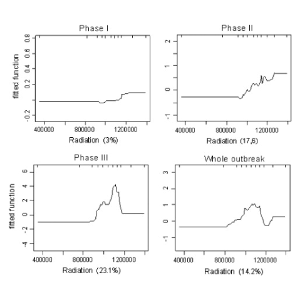 | Mezei, P; Grodzki, W; Blaženec, M; Škvarenina, J; Brandýsová, V; Jakuš, R Host and site factors affecting tree mortality caused by the spruce bark beetle (Ips typographus) in mountainous conditions Journal Article Forest Ecology and Management, 331 , pp. 196–207, 2014. Links | BibTeX @article{P.2014b,
title = {Host and site factors affecting tree mortality caused by the spruce bark beetle (\textit{Ips typographus}) in mountainous conditions},
author = {P. Mezei and W. Grodzki and M. Blaženec and J. Škvarenina and V. Brandýsová and R. Jakuš},
url = {http://www.sciencedirect.com/science/article/pii/S0378112714004691},
year = {2014},
date = {2014-11-01},
journal = {Forest Ecology and Management},
volume = {331},
pages = {196–207},
keywords = {},
pubstate = {published},
tppubtype = {article}
}
|
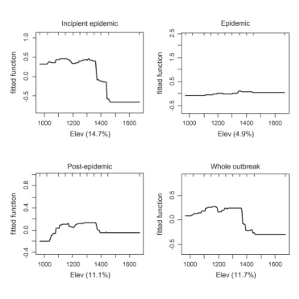 | Mezei, P; Grodzki, W; Blaženec, M; Jakuš, R Factors influencing the wind-bark beetles’ disturbance system in the course of an Ips typographus outbreak in the Tatra Mountains Journal Article Forest Ecology and Management, 312 , pp. 67–77, 2014. Links | BibTeX @article{P.2014b,
title = {Factors influencing the wind-bark beetles’ disturbance system in the course of an \textit{Ips typographus} outbreak in the Tatra Mountains},
author = {P. Mezei and W. Grodzki and M. Blaženec and R. Jakuš},
url = {http://www.sciencedirect.com/science/article/pii/S0378112713006877},
year = {2014},
date = {2014-01-01},
journal = {Forest Ecology and Management},
volume = {312},
pages = {67–77},
keywords = {},
pubstate = {published},
tppubtype = {article}
}
|
2012
|
 | Mezei, P; Jakuš, R; Blaženec, M; Belánová, S; Šmídt, J The relationship between potential solar radiation and spruce bark beetle catches in pheromone traps Journal Article Annals of Forest Research, 55 (2), pp. 243-252, 2012, ISSN: 18448135. Abstract | BibTeX @article{Mezei2012,
title = {The relationship between potential solar radiation and spruce bark beetle catches in pheromone traps},
author = {P. Mezei and R. Jakuš and M. Blaženec and S. Belánová and J. Šmídt},
issn = {18448135},
year = {2012},
date = {2012-01-01},
journal = {Annals of Forest Research},
volume = {55},
number = {2},
pages = {243-252},
abstract = {We analysed the relationship between the amount of potential solar radiation and spruce bark beetle Ips typographus(L.) catches in pheromone traps in an unmanaged nature reserve in the Carpathians (middle Slovakia region), from 2006 through 2009. This relationship was analysed under outbreak conditions. The number of traps varied in different years from 70 to 92. The traps were installed in spruce-forest-dominated stands affected by a windstorm in 2004. A GPS device was used to mark the position of the pheromone traps. The potential solar radiation was calculated with GIS tools for three different time periods in each year: with entire year, for main flight season of the spruce bark beetle and the spring swarming period. The relationship between the amount of potential solar radiation and the spruce bark beetle catches was statistically significant for each year and each time period except for the spring swarming in 2007, when the pheromone traps were not set up on time.},
keywords = {},
pubstate = {published},
tppubtype = {article}
}
We analysed the relationship between the amount of potential solar radiation and spruce bark beetle Ips typographus(L.) catches in pheromone traps in an unmanaged nature reserve in the Carpathians (middle Slovakia region), from 2006 through 2009. This relationship was analysed under outbreak conditions. The number of traps varied in different years from 70 to 92. The traps were installed in spruce-forest-dominated stands affected by a windstorm in 2004. A GPS device was used to mark the position of the pheromone traps. The potential solar radiation was calculated with GIS tools for three different time periods in each year: with entire year, for main flight season of the spruce bark beetle and the spring swarming period. The relationship between the amount of potential solar radiation and the spruce bark beetle catches was statistically significant for each year and each time period except for the spring swarming in 2007, when the pheromone traps were not set up on time. |
2011
|
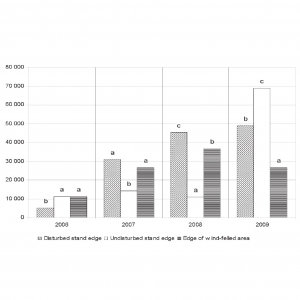 | Mezei, P; Jakuš, R; Blaženec, M; Belánová, S; Šmídt, J Population dynamics of spruce bark beetle in a nature reserve in relation to stand edges conditions Journal Article Folia Oecologica, 38 (1), pp. 73-79, 2011, ISSN: 13365266. Abstract | BibTeX @article{Mezei2011,
title = {Population dynamics of spruce bark beetle in a nature reserve in relation to stand edges conditions},
author = {P. Mezei and R. Jakuš and M. Blaženec and S. Belánová and J. Šmídt},
issn = {13365266},
year = {2011},
date = {2011-01-01},
journal = {Folia Oecologica},
volume = {38},
number = {1},
pages = {73-79},
abstract = {Over the period 2006–2009 spruce bark beetle (Ips typographus [L.]) population was monitored
after two windstorm events in a nature reserve in Slovak Ore Mountains. The monitoring was carried out with pheromone traps in three different forest edges: 1) edge of wind-felled trees area, 2)
disturbed stand edge and 3) undisturbed stand edge. The one-way ANOVAconfirmed statistically
significant differences among stand edges in each year and a post-hoc test was applied. In first
two years after the primary disturbance the most attractive for spruce bark beetle was the edge of
wind-felled trees area. After two years from the primary disturbance the most attractive became
the disturbed stand edge. The undisturbed stand edge showed a similar attractivity for spruce bark
beetles almost over the whole monitoring period.},
keywords = {},
pubstate = {published},
tppubtype = {article}
}
Over the period 2006–2009 spruce bark beetle (Ips typographus [L.]) population was monitored
after two windstorm events in a nature reserve in Slovak Ore Mountains. The monitoring was carried out with pheromone traps in three different forest edges: 1) edge of wind-felled trees area, 2)
disturbed stand edge and 3) undisturbed stand edge. The one-way ANOVAconfirmed statistically
significant differences among stand edges in each year and a post-hoc test was applied. In first
two years after the primary disturbance the most attractive for spruce bark beetle was the edge of
wind-felled trees area. After two years from the primary disturbance the most attractive became
the disturbed stand edge. The undisturbed stand edge showed a similar attractivity for spruce bark
beetles almost over the whole monitoring period. |

